By: Stacey Chamberlain
Mary Seereiter lives in Eugene, Oregon. She created, developed, and led the Dance Program at Lane Community College from 1980 to 2003. She pioneered a somatic curriculum including Body-Mind Centering, Authentic Movement, Anatomy for Dancers, and studies in Laban Movement Analysis (the primary form of movement notation used in Dance/Movement therapy).
Q: Can you recall an experience in your life when you really felt the healing potential of movement?
A: Yes, many times. I felt the healing potential of movement in my introduction to African dance when I first began dancing. I wasn’t ill, but at the time I was pregnant. Just to move my body during that time felt so amazing. It not only felt like a deeply spiritual experience, but it was also just this physicality that I’d never experienced before. Probably the biggest example was when I had breast cancer in 1999. Bonnie Simoa and I did a whole evening long concert on that. It was called Amazing Grace. At that time I was also getting my certification in Authentic Movement and I was totally able to [use that knowledge to] work through the emotional discomfort and just all that it brought up. It was Bonnie’s concert. She was the producer and main choreographer, although, she really engaged me in the creative process. We used a lot of what was happening for me in the Authentic Movement process to create particular solos for me. Even just a few days ago I had a rib go out, and it was really fun because when I went to the chiropractor I could tell him exactly what it was because of my body knowledge. The healing potential of dance, and movement—I don’t like to limit it to dance because I feel like any movement is dance—includes really listening to your body. Whenever you listen to your body, your body has a lot to tell you and it can help you heal if you truly listen.
Q: How does the practice of Authentic Movement teach you to listen to your body? What is that process?
A: You develop your internal witness. For example: if I had you move, I might have you close your eyes and wait for a movement impulse, and I would be the outside witness. The outside witness is very different than just watching someone. You’re not watching and analyzing, but you’re constantly checking in with your own body. You move for a certain amount of time and then the mover speaks about (as best they can) what movement happened, and what feelings were brought up. Then you just go deeper and deeper. Lastly, the witness speaks about what his or her experience was.


Leave a Reply